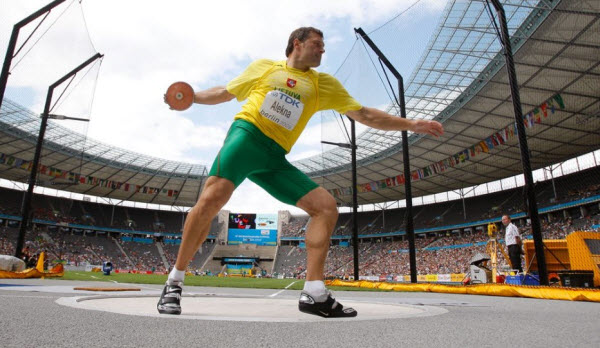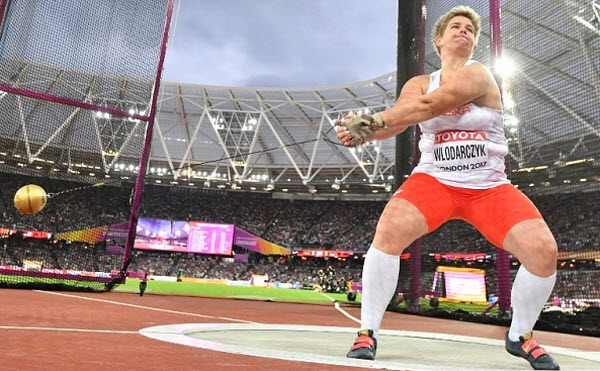Athletics, often called the “queen of sports,” encompasses a broad array of activities including running, walking, jumping, and throwing. In some regions, like the United States, it is known as track and field. As one of the oldest organized sports, athletics evolved from fundamental human activities such as running, walking, jumping, and throwing. Its universal appeal is evident as almost every country participates, sending teams to compete in the Olympic Games held every four years, along with official World Championships and various continental and intercontinental competitions.
General Organization
Athletics events are primarily conducted outdoors on open tracks where running events occur on a 400-meter oval track. Field events like jumping and throwing take place either on the infield or in adjacent areas. In colder climates, such as the United States, Canada, and Europe, athletics often move indoors during the winter season, leading to modifications or cancellations of certain events due to limited space. Additionally, separate competitions include cross-country running in diverse terrains such as countryside and parks, as well as marathons or long-distance road races. The International Association of Athletics Federations (IAAF) sets and enforces the rules and records for these events.
History of Athletics
Origins and Development
Records of early athletics as an organized sport are sparse. Ancient Egyptian and Asian civilizations promoted athletic activities centuries before the Christian era. By 1829 BCE, Ireland hosted the Teltian Games at the Langensad festival, featuring various track and field events, which are believed to have influenced the Greek Olympic Games. These games, dating back to 776 BCE, continued for about 11 centuries until around 393 CE. The Greek games were exclusively male, with women participating in their own Heraean Games held every four years. Modern athletics began to take shape in England with the establishment of training grounds in London in 1154, though it faced bans and revivals over the centuries, including a notable revival under Henry VIII in the 16th century.
Modern Evolution
The early 19th century marked the modern development of athletics, with amateur organizations established in England as early as 1825. By 1860, the sport gained popularity, with the West London Rowing Club organizing the first open meeting for amateurs. In 1866, the Amateur Athletic Club (AAC) was founded and hosted the first English championship. The AAC evolved into the Amateur Athletic Association (AAA) in 1880.

In North America, the first athletics event occurred near Toronto, Canada, in 1839. The New York Athletic Club, established in the 1860s, laid a foundation for the sport in the United States, contributing to the formation of the National Association of Amateur Athletes of America (NAAAA) in 1879. After nine years, the Amateur Athletic Union (AAU) took over as the national governing body.
By the late 19th century, athletics had become established in many countries, but it was the revival of the modern Olympic Games in 1896 that truly globalized the sport. The Olympics, starting modestly, inspired and standardized
global interest in athletics. The International Association of Athletics Federations (IAAF) was founded in Monaco in 1912. By 1987, the IAAF celebrated its 75th anniversary with over 170 national members, and its regulations applied to both men’s and women’s competitions.

Before World War II, major international athletics competitions included the Olympics, British Empire Games, and European championships. Post-war, athletics saw significant growth, especially in developing countries. By the 1950s, athletes from Africa, Asia, and Latin America began achieving remarkable success in international events.
Organization and Championships
Amateurism and Governance
Athletics competitions are primarily for amateur athletes. The IAAF has simplified the criteria for amateurism over time, focusing on adherence to rules and acceptance of changes. Initially, the IAAF aimed to prevent financial benefits for athletes, leading to conflicts. Some athletes and sponsors found ways to bypass rules, while certain Eastern European countries provided government support. By the 1980s, financial assistance through trust funds became accepted, allowing athletes to receive payments for appearances, performance, or endorsements, with funds held in trust for training expenses and retirement. Some athletes now earn substantial amounts annually under this system.
The IAAF’s primary functions include maintaining uniform rules globally, approving world records, promoting international athletics, and overseeing World Championships, which began in 1983. The IAAF also manages the World Cup, race walking, cross-country skiing, marathons, and other road races, as well as indoor track and field events and youth competitions.
Each IAAF member country has its own set of rules and maintains records according to international guidelines. National amateur athletic federations organize their own championships, with variations in event details based on location and competition level. Core athletics events are standardized according to IAAF rules, with outdoor track events taking place on a 400-meter oval track. Modern tracks use synthetic surfaces, while field event areas also use synthetic materials.
Event Structure
Athletics competitions vary in organization. School, college, or club meets typically last one day, while national championships take three to four days. World Championships and the Olympics span eight days of competition.
Track events start with a gunshot from an official. In sprints of one lap or less, runners stay in their lanes. In longer races, runners may disregard lane markers and run near the track’s inner edge. The first runner to reach the finish line wins. Field events feature qualifying rounds, with each athlete allowed three attempts. Approximately 12 athletes advance to the finals, continuing with the same format as qualifying, except in vertical jumps like the high jump and pole vault, where athletes have three attempts at each height and are eliminated after three consecutive failures.
Although athletics is primarily an individual sport, team scoring occurs in some meets. National meets often award 10 points for first place and decreasing points for subsequent positions, while international competitions may award 5, 3, 2, and 1 point for the top four positions. In cross-country events, scoring is reversed, with the lowest total points winning.

Doping Issues
Since around 1970, doping has been a major issue in athletics, with athletes banned from using performance-enhancing drugs. Testing is conducted at major competitions, with most athletes testing negative, though a few are caught each year. Violators typically face 18-month suspensions and often use steroids to increase muscle mass and strength.
Athletics Events
Sprints

Short Distances
Short sprints, up to 400 meters, require maximum speed. The current 100-meter world record holder is considered the fastest person on earth. Notable record holders include Eddie Tolan, Jesse Owens, Bobby Morrow, Bob Hayes, Carl Lewis (all from the U.S.), Valery Borzov (USSR), Linford Christie (UK), and Donovan Bailey (Canada). Maurice Greene of the U.S. set a record of 9.79 seconds in 1999, while Usain Bolt of Jamaica holds the record at 9.58 seconds. Notable female sprinters include Fanny Blankers-Koen (Netherlands), who won four gold medals in 1948, Wilma Rudolph (U.S.) with three golds in 1960, Marita Koch (East Germany), and Florence Griffith-Joyner (U.S.), who set world records in the 100 and 200 meters in 1988.
400 Meters
In the 400 meters, the staggered start compensates for varying distances from the inner edge of the track. Notable records include Lee Evans (U.S.) with 43.86 seconds in 1968, Michael Johnson (U.S.) with 43.18 seconds in 1996, and Kirani James of Jamaica, who won gold at the 2011 World Championships.
Middle Distances
800 to 1,500 Meters
Middle-distance events, ranging from 800 meters to 1,500 meters, require a balance of speed and endurance. Notable runners include Sebastian Coe (UK), who held world records for both distances, and Hicham El Guerrouj (Morocco), who set records for the 1,500 meters, mile, 2,000 meters, and 2,500 meters. Notable female runners include Jelimo (Kenya), who set a world record in the 800 meters, and Genzebe Dibaba (Ethiopia), who set the 1,500 meters record.
Long Distances
5,000 and 10,000 Meters
Long-distance events include the 5,000 and 10,000 meters. The 5,000 meters, added to the Olympics in 1912, was won by Paavo Nurmi (Finland) in 1924. The 10,000 meters, introduced in 1928, was won by Emil Zatopek (Czechoslovakia) in 1952. Notable records include Kenenisa Bekele (Ethiopia) with a 5,000 meters record in 2004 and Haile Gebrselassie (Ethiopia) with a 10,000 meters record in 1998.
Marathons
The marathon, an ancient Greek event revived in 1896, covers 42.195 kilometers (26 miles 385 yards). Records include Eliud Kipchoge (Kenya) with a time of 2:01:09 set in 2018 and Brigid Kosgei (Kenya) with a time of 2:14:04 set in 2019. The marathon is also held as a road race, including cross-country and mountain races.
Steeplechase
The 3,000-meter steeplechase features barriers and a water jump. The world record is held by Saif Saaeed Shaheen (Qatar) at 7:53.63 minutes, with Beatrice Chepkoech (Kenya) holding the women’s record at 8:44.32 minutes.
Hurdles

Hurdles events typically include 100 meters for women and 110 meters for men. The 400-meter hurdles race involves a single lap with 10 hurdles. Records include Sally Pearson (Australia) for the 100 meters hurdles and Edwin Moses (U.S.) for the 400 meters hurdles.
Relays

Relays include the 4×100 meters and 4×400 meters, with teams of four runners passing a baton. Notable teams include the U.S. in the 4×100 meters and Jamaica in the 4×400 meters. Relay races require precise baton exchanges and coordination.
Field Events
Jumping Events
High Jump

The high jump involves leaping over a horizontal bar, with competitors attempting to clear progressively higher bars. Records include Javier Sotomayor (Cuba) for men with 2.45 meters and Stefka Kostadinova (Bulgaria) for women with 2.09 meters.
Pole Vault

The pole vault requires jumping over a high bar using a flexible pole. The current record is held by Armand “Mondo” Duplantis (Sweden) at 6.21 meters for men and Yelena Isinbayeva (Russia) at 5.06 meters for women.
Long Jump

The long jump involves jumping as far as possible from a takeoff board. The record is held by Mike Powell (U.S.) with 8.95 meters and Galina Chistyakova (USSR) with 7.52 meters.
Triple Jump
The triple jump, also known as the hop, step, and jump, involves three distinct phases. Records include Jonathan Edwards (UK) at 18.29 meters for men and Inessa Kravets (Ukraine) at 15.50 meters for women.
Throwing Events
Shot Put

The shot put involves throwing a heavy metal ball as far as possible. The record is held by Ryan Crouser (U.S.) with 23.37 meters and Natalya Lisovskaya (USSR) with 22.63 meters.
Discus Throw

The discus throw involves throwing a heavy disc as far as possible. Records include Jürgen Schult (East Germany) with 74.08 meters and Gabriele Reinsch (East Germany) with 76.80 meters.
Javelin Throw

The javelin throw involves throwing a spear-like object as far as possible. Records are held by Jan Železný (Czech Republic) with 98.48 meters and Barbora Špotáková (Czech Republic) with 72.28 meters.
Hammer Throw

The hammer throw involves swinging a heavy weight attached to a wire around the athlete’s head and throwing it as
far as possible. Records include Pawel Fajdek (Poland) with 82.98 meters and Anita Wlodarczyk (Poland) with 82.98 meters.
Multi-Events
Decathlon
The decathlon combines 10 events, including sprints, jumps, and throws. The record is held by Kevin Mayer (France) with 9,126 points. The decathlon is known for its grueling schedule, testing athletes’ versatility and endurance.
Heptathlon
The heptathlon consists of seven events: 200 meters, 800 meters, 100 meters hurdles, high jump, long jump, shot put, and javelin. The record is held by Nafissatou Thiam (Belgium) with 7,013 points. The heptathlon tests athletes’ range and adaptability.
